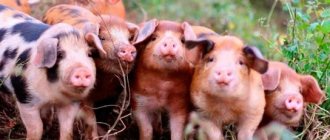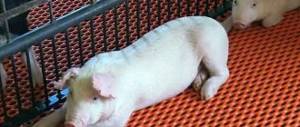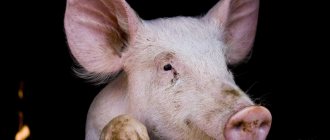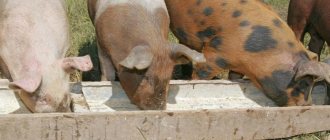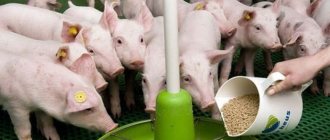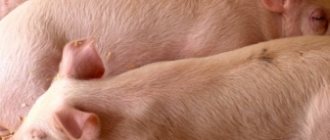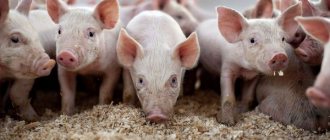At the beginning of the 20th century, farms in these regions mainly raised large white animals. They were obtained from crossing local pigs and English white large boars. The individuals were not well adapted to local climatic conditions and the available food supply.
In 1926, on the basis of the state experimental station “Askania-Nova” (Kherson region), M.F. Ivanov began work on improving local pigs. The team of scientists was given the following tasks:
- increase the strength of the constitution of pigs;
- shorten the period of maturation (reaching sexual maturity);
- increase overall stability and adaptability to high temperatures;
- increase fertility.
In addition, it was necessary to preserve the valuable properties of local pigs. The 6 best pigs weighing 110-120 kg were selected for breeding. A boar of a large white breed (weight - 384 kg) was delivered from the plant named after M.M. Shchepkin. However, only in the second generation it was possible to obtain animals with the necessary proportions of the desired parameters (fertility, constitutional strength, maturation time). In 1934, the Ukrainian steppe white breed of pigs was officially registered in the State Register.
The result of the selection work of Academician M.F. Ivanov was not only a new highly productive breed of pigs. A unique technique was created for the selection of domestic breeds.
The work begun was continued by Academician L.K. Let's comb. Individuals of the Ukrainian white breed of pigs became parents when bred by the Ukrainian steppe speckled pockmarked pig.
Standards
The Ukrainian steppe white pig belongs to the universal meat-and-fat type. The yield of meat is 55.5%, and high-quality lard – 35.3%. Individuals are early ripening: already on days 192-209 they can reach a weight of 100 kg. At the same age (7.5-8 months) pigs are ready to mate.
Constitution
There are significant differences from the large white breed, which are clearly visible in external characteristics. Ukrainian steppe breed pigs have an elongated muzzle with a slightly concave profile, a long snout and large ears that droop to eye level. The wide and deep body with a sloping back is securely held by short, strong legs with well-defined hams. The new breed of pigs looks much more powerful and stronger than the large white ones.
The described body features make it possible to adapt well to the arid conditions of the steppe regions, to endure frequent and sudden changes in temperature and atmospheric pressure, and frosty, windy winters without losing weight. Ukrainian white steppe pigs have practically no disadvantages. Only the sagging sacrum can be distinguished, which spoils the exterior of the individual. All pigs are prone to obesity.
Color, weight and dimensions
The tough white skin of pigs is densely covered with long bristles.
| Characteristic | Boar | Sow |
| Weight | 310-340 kg (up to 400 kg) | 220-260 kg (up to 285 kg) |
| Body length | 130-150 cm (maximum – 185-190 cm) | 120-140 cm (maximum -160-172 cm) |
| Circumference around the chest | 145-170 cm | 120-140 cm |
Productivity and Fertility
In one litter, a sow usually gives birth to 11-12 piglets. However, when elite (breeding) individuals mate, an offspring of about 20 newborns is possible. Piglets quickly gain weight (average daily gain is 700-701 g), which is ensured by the good milk production of the sow (about 60-80 kg). At the age of 7-8 months, their weight approaches 100 kg. A one-year-old pig can weigh about 180 kg.
The slaughter yield of products from one Ukrainian steppe white pig is 83-84%. High quality meat and lard. Lard thickness is 26-30 mm. After reaching sexual maturity (7-8 months), pigs begin to intensively accumulate fat. Therefore, you can get high-quality meat by raising young animals.
Features of feeding and maintenance
Thanks to their strong constitution and dense bristles that thickly cover their skin, Ukrainian white steppe pigs tolerate the difficult conditions of an arid climate well. At night, they can remain on the summer pasture, and the barns where the animals are kept do not require artificial heating.
The diet of Ukrainian white pigs raised in steppe regions consists of 80% non-nutritious feed, grain production waste, bran, and chaff. They are rich in fiber, but are difficult for animals to digest due to the structure of the gastrointestinal tract.
Sufficient quantities of dry food are consumed during grazing. Therefore, when kept in stalls, combined feeds (potatoes, carrots, young ears of corn) are included in the diet. For 1 kg of weight, 4.12 feed units are required.
Meat and fish waste degrades the quality of meat and lard. Therefore, several weeks before slaughter they are not added to the pigs’ diet. And dairy products (skim milk, whey, buttermilk) are beneficial for pigs at any age.
Content
Keeping animals does not differ from the rules for caring for other breeds, but there is an essential condition - a heated pigsty.
It is important to have ventilation in the room, covering the floor with hay, sawdust or straw. It is advisable to install heaters in the winter
The walls of the pigsty must be stable and strong. The animals are not violent, but they are capable of breaking thin structures. Wooden floors and surfaces are most often damaged due to pigs rubbing against them. The open area in front of the pigsty is covered with a canopy. The sun's rays can cause burns to a pig's skin if the animal is exposed to the sun for a long time, so it is necessary to protect them from overheating.
The immune system of cattle is strong. Diseases are rare, but the animal is still susceptible to common livestock diseases such as pneumonia. Symptoms: cough, fever, lacrimation, increased salivation, rapid or intermittent breathing.
The only measure available to the farmer before the doctor arrives is to “bring down” the temperature. Paracetamol is suitable as a common medicine. The daily dose is equal to a gram. The tablet is ground and then dissolved in water. The resulting liquid is given to the animal. Antibiotics may be required to treat the disease. Sick pigs should also consume anti-inflammatory drugs. The dosage is prescribed by the doctor, taking into account the weight of the animal, the stage of the disease, and the age of the animal.
Overheating of the animal from the sun also leads to a deterioration in the condition of the pig’s body. Symptoms: lack of irritation to external sources (other animals, sounds, etc.), inhibited reflexes, depressed state, variability of gait, uneven breathing, rapid pulse.
Breeding prospect
In 1968-1971, at the Sivashskaya experimental research station, an experiment was conducted on intensive fattening of young Ukrainian white steppe pigs. As a result, already at the age of 2 months, the piglets weighed 100 kg. The circumference measurement in the muscle eye area was 28.5-29.5 cm. Some piglets showed an average daily weight gain of 750 g, while 3.4-3.5 feed units were consumed per 1 kg of live weight. The weight of the boar was recorded - more than 400 kg, and the sow - 285 kg.
Currently, Ukrainian steppe white pigs are bred on farms in Ukraine (Nikolaev, Odessa, Kherson, Zaporozhye regions) in the steppe regions of Armenia, Moldova, Turkmenistan, Azerbaijan, in some regions of Russia (Krasnodar and Stavropol Territories, Rostov and Volgograd regions, North Caucasus) . Breeding work is underway to improve meat quality and early maturity.
What breed of pigs do you raise? Write in the comments .
Author: Marina Usenko
The main large white hybrids, their brief characteristics and description
In Russia, pedigree Englishwomen are loved for their good endurance and versatility - they can express themselves in both meat and lard areas. When slaughtering piglets up to 100 kg, you can get a good yield of lean meat; fatty meat and bacon are taken from adult animals.
Ukrainian Large White or White Steppe
The White Steppe is one of the first crossbred species, which was created in Ukraine in 1934. Local pigs, adapted to the winds and drought of the southern steppes, as well as purebred English pigs, took part in its breeding.
This breed of pig is adapted to grazing on pastures, gains weight well on green grass feed, tolerates windy, cold winters and hot, dry summers well, and is unpretentious in maintenance.
White steppe breeding areas: in the south of Ukraine, less often in the Krasnodar Territory and Rostov Region. It can be found even in Moldova, Turkmenistan and Armenia.
In size and meat quality it is not inferior to its English relatives, it suffers less often from the absence of offspring and the mortality of young animals, but according to its constitution it is a little rougher. Pigs of this breed are large, an adult sow weighs 250 kg, and a wild boar weighs 330-350 kg. Distinctive features are a long narrow head and long light bristles.
Belarusian large white
The Belarusian Large White was obtained by crossing Yorkshire breeding animals with local Belarusian pigs. Its characteristics are similar to those of English pigs. But the animals are adapted to the local climate, have multiple births, show better survival of offspring, and are able to gain weight well when fed on grass.
On the territory of the Republic of Belarus, of all breeds of pigs raised, the Belarusian Large White accounts for 90%.
The hybrids bred in Russia (as well as in other countries) differ from the English one, as they were created by crossing with local pigs. As a result of such selection work, highly productive animals were obtained, well acclimatized and adapted to the natural conditions of our country.
The Breitovskaya breed was obtained in the Yaroslavl region from several bloodlines: Landrace, Polesie, Large White and Medium White. Areas of distribution of this breed: Yaroslavl, Smolensk, Ivanovo, Leningrad regions.
In 1942, the Siberian northern breed was approved. To obtain it, boars of the large white breed and local sows were used, and the hardening of young stock played a special role. The result was a hybrid pig that was frost-resistant, hardy, and showed high meat and lard productivity.
The Northern Siberian has light, sometimes reddish, long bristles with undercoat, which protect the animal from the cold in winter and from blood-sucking insects in summer. Weight reaches 240-280 kg for boars and 200-230 kg for sows. For pigs to grow well, their feed must contain a large amount of protein.
Breeding this breed is popular in the Novosibirsk region and Krasnoyarsk region. The Kemerovo breed is classified as a meat and fat breed. She was bred in a complex way, crossing Siberian pigs with large white ones. The English Large Black and Berkshires also took part in the creation of the hybrid. The result was animals that retained the qualities of the Yorkshire breed, hardy and resistant to cold, but demanding of feed.
The breed was approved in 1960, and to this day it is widely used in the industrial raising of pigs in Siberia, Kazakhstan and other areas with harsh climates.
Large white breed: breeding and importance for agriculture
There are only a small number of pig breeds used in the world today. But the large white and its hybrids are distributed almost throughout the globe. It was the Yorkshires that became the basis from which almost all currently known breeds of pigs were obtained.
In our country, all existing breeds of pigs were bred with the participation of large white, which is recommended to be used as a mother pig. And currently the share of this breed in Russia is more than 87% of the total livestock.
Breeding new breeds becomes more difficult every year, as increasingly high demands are placed on breeding animals. But even in such conditions, the large white remains one of the most promising in future breeding.
